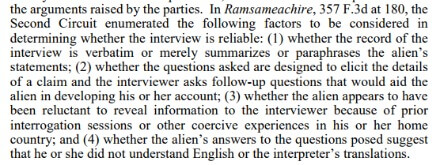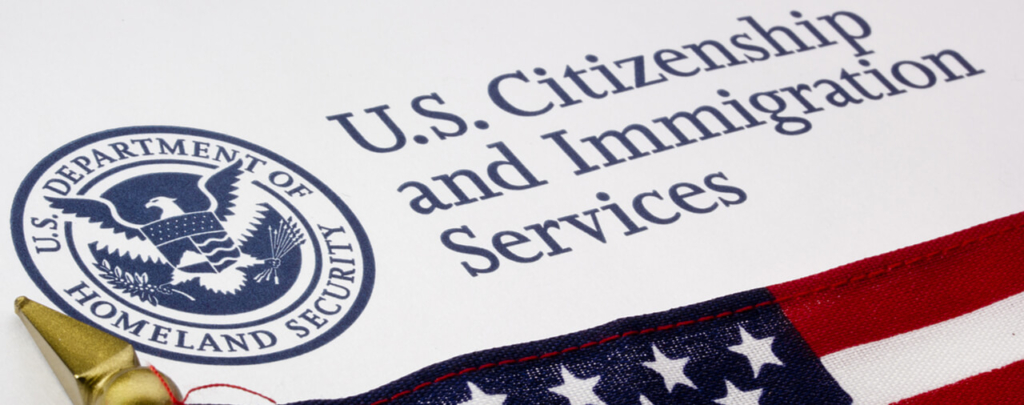- Introduction: Mater of J-C-H-F-, 27 I&N Dec. 211 (BIA 2018)
- Factual and Procedural History: 27 I&N Dec. at 211-12
- Analysis and Conclusions
- Border and Airport Interviews: 27 I&N Dec. at 212-15
- Applying Rule to Applicant’s Claims: 27 I&N Dec. at 215-17
- Claims under the Convention Against Torture: 27 I&N Dec. at 218
- Conclusion
Introduction: Mater of J-C-H-F-, 27 I&N Dec. 211 (BIA 2018)
On February 20, 2018, the Board of Immigration Appeals (BIA) issued a published decision in the Matter of J-C-H-F-, 27 I&N Dec. 211 (BIA 2018) [PDF version]. The Matter of J-C-H-F- dealt with the question of when an Immigration Judge should consider a border or airport interview in making a credibility determination regarding an alien’s application for protection. The Board held that in this case, “an Immigration Judge should assess the accuracy and reliability of the interview based on the totality of the circumstances, rather than relying on any one factor among a list or mandated set of inquiries.
In this article, we will examine the factual and procedural history of Matter of J-C-H-F-, the Board’s analysis and conclusions, and what the new precedent means going forward.
Factual and Procedural History: 27 I&N Dec. at 211-12
Matter of J-C-H-F- involved an applicant for protection under the Convention Against Torture (CAT).
The applicant, a native and citizen of Mexico, attempted to enter the United States on April 20, 2010. On that occasion, he stated in a border interview that he came to the United States to look for his father, further stating that his father had gone to the United States three years prior and that he had not hear anything from his father since. The applicant stated that he only intended to stay in the United States for a week or two. In the interview, the U.S. Customs and Border Protection (CBP) officer asked the applicant whether he feared persecution or torture if he returned to Mexico. In response to the question about whether he feared persecution or torture in Mexico, the applicant stated “no.” The applicant then signed a sworn statement before the CBP officer and was removed on April 20, 2010.
On May 11, 2016, the applicant returned to the United States illegally. The Department of Homeland Security (DHS) reinstated the applicant’s prior removal order from 2010. In response to the reinstatement of the prior removal order, the applicant sought protection under CAT, claiming that he feared that he would be tortured by the Michoacán Cartel if he was returned to Mexico. In support of his claim, the applicant stated that members of the cartel had gone to his aunt’s house in March of 2010 and kidnapped his father. The applicant claimed that, two days later, the Cartel returned to the house to kidnap him and threatened to brutally murder him just as they had his father if he did not provide them with certain information. The applicant asserted that he had been released once the Cartel was satisfied that he was not a member of a rival cartel. The applicant claimed that he had not seen his father since his father had been kidnapped.
Because the applicant was subject to reinstatement of removal and because he asserted a fear of torture, he was placed in withholding of removal only proceedings where only his application for protection under CAT would be considered. The Immigration Judge found that the applicant lacked credibility due to discrepancies between his statement when interviewed in 2010 and his testimony in 2016. Based on this adverse credibility finding, the Immigration Judge denied the respondent’s application for CAT.
The respondent appealed from the denial to the BIA. The respondent argued that the Government documents that the Immigration Judge relied upon in making the adverse credibility finding were not reliable. The respondent took the position that the evidence in the record demonstrated that he provided credible testimony.
Analysis and Conclusions
The Board’s analysis in Matter of J-C-H-F- is broken into three sections. First, the Board examined how to consider border and airport interviews in assessing an applicant’s credibility. This second of section contains the Board’s main precedential conclusion in the case. The second and third sections dealt with the applicant’s credibility and with his eligibility for protection under CAT. For reasons that we will examine, the Board would ultimately dismiss the applicant’s appeal.
Border and Airport Interviews: 27 I&N Dec. at 212-15
The respondent challenged the reliability of his border interview and argued that the Immigration Judge should not have relied upon it in making an adverse credibility finding. Citing to Espinoza v. INS, 45 F.3d 308, 310 (9th Cir. 1995) [PDF version], the Board explained that there is, in general, a presumption of reliability of Government documents.
The Board stated that in order for information obtained by the DHS at border or airport interviews to be usable in removable proceedings, the information “must be both accurate and reliable for the purposes for which the document is being used.”
The instant case arose in the jurisdiction of the United States Court of Appeals for the Ninth Circuit, meaning that any Ninth Circuit precedents on pertinent issues would be binding. The Board noted that the Ninth Circuit had, in multiple precedent decisions, reversed adverse credibility findings based on border or airport interviews where the interviews were found to have lacked adequate safeguards. For example, see Yan Xia Zhu v. Mukasey, 537 F.3d 1034, 1040-41 (9th Cir. 2008) [PDF version]. The Board also cited to decisions from other circuits to the same effect, including the Third, Seventh, and Eleventh Circuits (see 27 I&N Dec. at 212-13). However, the Ninth Circuit, as well as several other circuits, have also upheld adverse credibility findings based on border or airport interviews upon finding adequate indications of their reliability. To this effect, the Board cited to Li v. Ashcroft, 378 F.3d 959, 962-63 (9th Cir. 2004) [PDF version], and decisions of the First, Second, Fourth, and Eleventh Circuits as well (see 27 I&N Dec. at 213).
The Board explained that, under statute, Immigration Judges have the discretion to consider “the totality of the circumstances, and all relevant factors” in making a credibility determination. Significantly, Congress provided Immigration Judges discretion to consider “the consistency between the applicant’s or witness’s written and oral statements (whenever made and whether or not under oath, and considering the circumstances under which statements are were made)…” Furthermore, Immigration Judges may properly consider “the consistency of such statements with other evidence of record.” The Board interpreted these provisions as “encompass[ing] statements made in border and airport interviews as long as the Immigration Judge takes into account any issues regarding the circumstances under which they were made.”
After reviewing published circuit court decisions on the issue, the Board explained that the first point to consider is “whether there are persuasive reasons to doubt the alien’s understanding of the interviewer’s questions.” For example, the Board cited to Nadmid v. Holder, 784 F.3d 357, 360-61 & n.1 (7th Cir. 2015) [PDF version], wherein the Seventh Circuit found reason to doubt the alien’s understanding where the interpreter spoke in a language in which the alien had minimal proficiency. Regarding the alien’s understanding, the Board held that “[t]he most basic consideration is whether an interpreter was provided if one was requested.” To this effect, it cited to the Third Circuit decision in Senathirajah v. INS, 157 F.3d 210, 213 (3d Cir. 1998) [PDF version].
The Board stated that if the alien’s statements from a prior interview are being contrasted with statements given in subsequent testimony, “it is important to have a detailed and reliable recitation of questions and answers from the interview.” In Matter of S-S-, 21 I&N Dec. 121, 124 (BIA 1995) [PDF version], the Board emphasized the importance of having “a reliable record of what transpired at [the] interview” in order to “evaluate questions with respect to credibility.” Citing to Ramsameachire v. Ashcroft, 357 F.3d 169, 180 (2d Cir. 2004) [PDF version], the Board explained that an interview should be designed “to elicit the details of an asylum claim.” The Board noted that some published circuit court decisions have recognized that individual circumstances may affect the reliability of an individual’s answers in an interview. In one of several examples cited to by the Board, the Third Circuit held in Fiadjoe v. Att’y Gen. of U.S., 411 F.3d 135, 159-60 (3d Cir. 2005) [PDF version], that a female alien who had suffered sexual abuse in her home country may be less willing to testify in detail about that trauma to a male immigration official than she would be to a female immigration official.
The Board cited to the Second Circuit decision in Ramsameachire, 357 F.3d 169, 180 (2d Cir. 2004), for a checklist of four factors thar should be considered in evaluating whether a past interview is reliable such that it can be compared to subsequent statements by an alien. However, the REAL ID Act of 2005, which provided the relevant statutes regarding factors to be considered in making credibility determinations, was codified subsequent to Ramsameachire. We have excerpted the Board’s summary of the enumerated factors in Ramsameachire below:

However, in a recent decision, the First Circuit rejected reliance on the four factor test in Ramsameachire in its own published decision, Ye v. Lynch, 845 F.3d 38, 44 (1st Cir. 2017) [PDF version]. The First Circuit reasoned that in light of the REAL ID Act, Immigration Judges are not required “to undertake an inquiry into the reliability of initial interviews with Border Patrol agents using specifically enumerated factors.”
The Board agreed with the First Circuit’s position in Ye. It noted that the factors listed by the Second Circuit in Ramsameachire “were proper considerations.” However, the Board held that, under the REAL ID Act, “the Immigration Judge should assess the accuracy and reliability of the interview based on the totality of the circumstances, rather than relying on any one factor among a list or mandated set of inquiries.” The Board added that the REAL ID Act also creates the presumption “that interviews of this nature are proper to consider in an adverse credibility determination.” However, the Board noted that Immigration Judges “should address any arguments raised regarding the accuracy and reliability of the interview and explain why the arguments are not persuasive.”
Applying Rule to Applicant’s Claims: 27 I&N Dec. at 215-17
The applicant based his claim that his 2010 interview at the boarder was unreliable on three main contentions:
He had difficulty understanding the immigration officer;
He did not remember if he was asked about his fear of harm upon return; and
The resulting statement was in English, which he could not read.
However, the Board explained that the record supported the Immigration Judge’s conclusions.
First, the Board explained that the Form I-867A, Record of Sworn Statement in Proceedings under Section 235(b)(1) of the Act, which was prepared during the applicant’s 2010 border interview, “contains a detailed recitation of the questions and answers relating to the applicant’s claim, including the purpose of his visit, the length of his stay, and the issue whether he feared any harm if he returned to Mexico.” The Form I-867A stated that the interview was conducted in Spanish. Although no separate interpreter was used for the Spanish-language interview, the Board found that “[t]he record does not indicate that [the applicant and the interviewer] struggled to communicate or that there was any misunderstanding regarding the matters discussed.” In immigration hearings, the applicant acknowledged that he can read and understand English. The applicant had initialed each page of the Form I-867A. The record also contained a Form I-867B, which included a statement affirming the truth and accuracy of the applicant’s responses. This form was signed by the applicant and the interviewing officer in the presence of a second CBP agent.
The Board explained that, under 8 C.F.R. 1003.1(d)(3)(i), the Immigration Judge is responsible for determining the accuracy and reliability of DHS interviews. This is then reviewed by the BIA for “clear error.” Under this standard, the Board found that, in light of the evidence, the Immigration Judge did not clearly err in finding that the applicant’s border interview documents “were accurate and reliable and could properly be considered in the context of making his credibility determination.”
Next, the Board assessed whether the Immigration Judge’s adverse credibility determination itself was “clearly erroneous.” The Board concluded that it was not, finding that the adverse credibility determination was based “on specific and cogent reasons, which involved discrepancies between the applicant’s testimony and documentary evidence, as well as his implausible explanations for such inconsistencies.”
The Board noted multiple serious discrepancies between the applicant’s 2010 sworn statement in his border interview and his claim in the instant case for protection under CAT. For example, the Board noted that “the applicant’s statement in his interview that he was in the United States to look for his father, who came to this country 3 years earlier, directly contradicted his later claim that his father was kidnapped and brutally murdered shortly before the applicant’s arrival at the border.”
The Immigration Judge also noted other inconsistencies in the applicant’s 2016 testimony that supported the adverse credibility determination. For example, the applicant testified that after being kidnapped and beaten, he had received medical treatment, including stitches. However, the Immigration Judge took note of the fact that the doctor’s letter in the record did not discuss any specific injuries, stitches, or specific treatment that was provided. Furthermore, there was no indication that the doctor found that the applicant was covered in bruises, which was another claim made by the applicant. The applicant testified that he did not discuss the kidnapping and beating with his doctor. While the Board acknowledged that this may be true, and that the applicant’s aunt had made the appointment, it found that “this possibility does not sufficiently explain or undermine the multiple discrepancies concerning the letter.” The applicant also argued that the discrepancies were not “internally inconsistent or inherently implausible.” However, the Board explained, the Immigration Judge need not interpret evidence in the manner proposed by the applicant.
The Board concluded that the Immigration Judge had considered the applicant’s explanations for the discrepancies before deciding to reject them based on other plausible ways of looking at the evidence. The Board cited to the decision of the full Ninth Circuit in Mondaca-Vega v. Lynch, 808 F.3d 413, 426 (9th Cir. 2015) (en banc) [PDF version], wherein it stated that “[a]s long as ‘there are two permissible views of the evidence, the fact finder’s choice between them cannot be clearly erroneous.’” The Board had held similarly in Matter of J-Y-C-, 24 I&N Dec. 260, 263 (BIA 2007) [PDF version].
Based on the aforementioned facts, the Board found no clear error in the Immigration Judge’s adverse credibility determination “based on the significant inconsistencies in the applicant’s statements and his unpersuasive explanations for those discrepancies…”
Claims under the Convention Against Torture: 27 I&N Dec. at 218
The Board agreed with the Immigration Judge that the applicant did not establish that he warranted relief under CAT, which required him to establish that it was “more likely than not” that he would be tortured upon return to Mexico either at the instigation of or with the consent or acquiescence of someone acting in an official capacity. The Board concluded that, because the applicant lacked credibility and because evidence in the record did not independent establish his claim, he failed to meet his burden.
Please see our main article on CAT relief to learn more about the subject [see article].
Conclusion
In Matter of J-C-H-F-, the Board made clear that the Immigration Judge is not limited to considering a pre-set list of factors in determining whether to consider a border or airport interview in making a credibility determination. Instead, the Immigration Judge should “assess the accuracy and reliability of the interview based on the totality of the circumstances…” In short, Immigration Judge’s may assess a variety of factors pertaining to a border or airport interview in determining whether it should be considered in making a credibility determination.
The process for applying for asylum, withholding of removal, or protection under CAT is evidence-intensive. An alien should always consult with an experienced immigration attorney throughout the proceedings for case-specific guidance.



-1024x405.jpg)
-1024x405.jpg)
